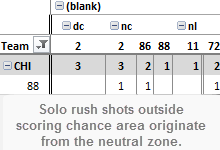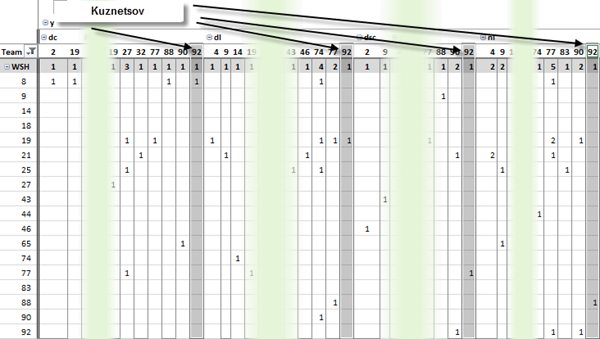Going over some of the passing project data as part of its second release in late January, intrigued by the possibilities offered in adding layers in game theory. I wrote about breakouts and solo rushes as examples.
I define a solo rush as when a player receives a pass originating from the defensive or neutral zone and leads to a shot on goal without another pass event. There’s the assumption the sequence leads to the eventual shot event. The project doesn’t track data that without an eventual shot attempt. Aside from that, we can drill down and isolate game situations adding a beneficial element to player/team analysis. I’ve expanded more here.
Maple Leafs center Nazem Kadri was an example of a solo rush tendency when the pass originated from the neutral or defensive zone and ended as a shot attempt within or outside of a scoring chance area.
Looking for a discernible pattern, trying to identify a preferred side of the ice, or passing partner. The images below are from pivot tables analyzing this data with its layers. Pivot tables are great, offering filter capability for individual categories. My pivot tables is described below.
Player taking the solo rush that led to a shot on goal is listed on the left. There are three layers to the column headings.
- Y & (blank) refers to whether or not the shot on goal was generated within the scoring chance home plate area (signified by a ‘Y’) or outside of scoring chance area (blank).
- Next layer is the zone in which the primary pass originated before the solo rush.
- Player that made the final pass prior to the shooter and the shot on goal.
This data is all 5v5. Passes originated from the defensive zone led to less shots from the scoring chance area than passes from the neutral zone. Passes from the defensive zone originated from defenseman, yet neutral zone passes were generated mostly from forwards, in this case either Brad Boyes or Leo Komarov. Shots outside of the scoring chance area were a result of a primary pass received in the neutral zone originating from a forward.
Kadri doesn't get many stretch passes or outlets from defenseman and heads in on all alone. Most passes are from the neutral zone, implying he's the secondary passing option after controlled breakout or a regroup. He's likely to spearhead the rush, but could have support.
Chicago had 28 games tracked, and I wanted to take a look at what leading scorer Patrick Kane looks like when a pattern emerged. Shots from scoring chance area were primarily from an initial pass originating from the defensive zone. Very few shots in the scoring area initiated from neutral zone passes. It seems like Kane likes the long pass to gauge options and create a scoring opportunity. A neutral zone pass leads to less drive to get into scoring areas.
Shots outside of a scoring chance area featured very few passes from the defensive zone. They were more likely to come from the neutral zone.
Curiosity led me to check this with another NHL goal scoring star, and Alex Ovechkin performs under similar conditions. The few solo rushes generating a shot on goal offers balance between passes from the defensive or neutral zone. Outside shots were from neutral zone passes and generally from a forward.
Evgeny Kuznetsov, ranked fifth in the NHL in points and third overall in assists is tallied 18 at 5v5 with 16 being first assists. Conspicuous in their absence from isolating solo rushes are a lot of primary passes recorded considering he's got 16 first assists.
With more games tracked, especially full seasons, there's some excellent possibilities of expanding this to make game play decisions. If most passes in the neutral zone lead to shots from outside the scoring area (still only a theory with such little data to work with), the value in learning to play those occurrences could be a vital coaching implementation.
************************
Follow the McKeen's team on Twitter:



































